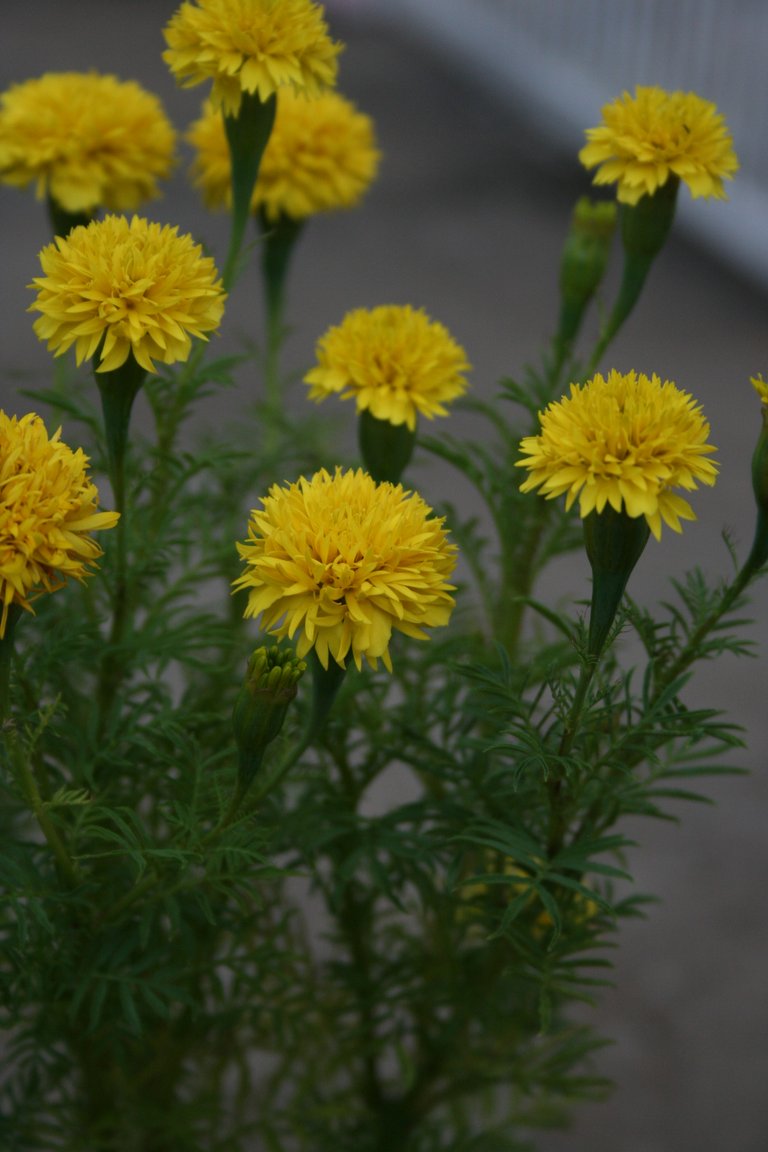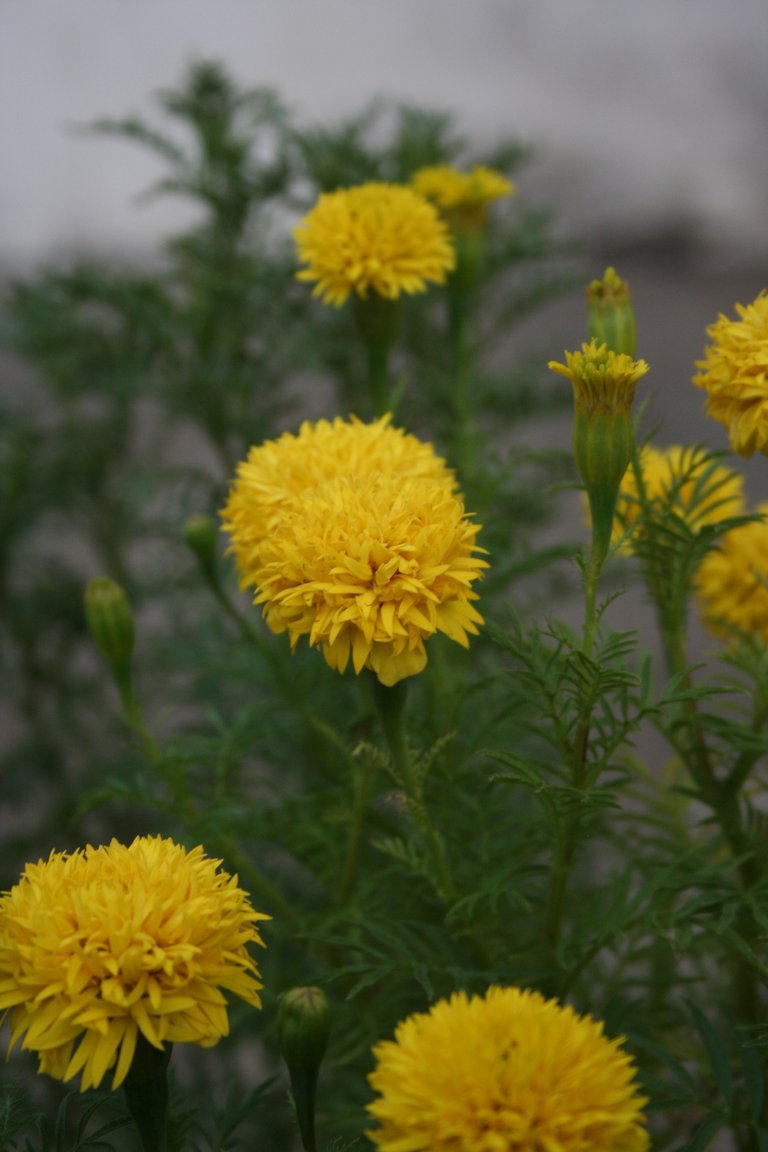
Hello community, today I share this beautiful plant popularly called "chrysanthemum" as my entry on the amazing Nature contest. This plant is very famous in my country, it is widely used at weddings, celebrations, for gifts of all kinds, and especially at funerals for wreaths and to place on top of graves. Today I understand why, since I just planted one of these little plants that the owner of the plant gave me as a gift from a neighbor of mine, I will tell you how the experience was: I was passing by her house on the way to the winery and I was very surprised to find a plant that I have only seen in flower shops, (yes, they are much larger) this species is smaller, I imagine because of the type of soil. After researching, I realized that the climate, the type of soil, the fertilizer, etc. have a great influence.

Care of chrysanthemums The chrysanthemum is a very versatile plant that requires very simple care: > Light: to grow leafy and with thick foliage, chrysanthemums need about 8 hours of sun, whatever the species. Although they do not tolerate direct sunlight very well, so the ideal is for the sun to fall on it first thing in the morning and last (around 2 or 3 in the afternoon). Too much direct light can cause its flowers and leaves to burn. Irrigation: it is done when the substrate is more or less dry, especially in those grown in pots. To check it, insert a stick (or your finger) into the pot and, if a lot of adhered soil comes out, you don't need to water it. 2 or 3 times a week may be enough and preferably first thing in the morning (which could cause the appearance of fungus). If you over-water it, the soil can become flooded and the foliage wet, giving rise to different types of fungi or rust disease. Although excess watering is dangerous and, in addition to the origin of certain diseases, it can cause the plant to die. The truth is that chrysanthemums are a species that like humidity (around 60-70%). You should also avoid wetting the leaves and flowers, as they would be spoiled. potted chrysanthemums in garden > Temperature: chrysanthemums are one of the most appreciated flowers in the cold seasons due to their abundant flowering. The perfect temperature for its development is between 12 and 17 ºC. It does not tolerate high temperatures well, so in climates where temperatures do not exceed 20 ºC it can be grown throughout the year.
Wikipedia

My neighbor gave me some flowers and told me to "let the flowers dry and distribute the petals on the ground." The truth is that although it seemed strange to me, I took the enchanted flower and gave myself the task of carrying out the experiment but no, "the plant stuck to me" as we say in my country Venezuela. On a second chance, she was cutting them back because they grow quite tall, although they are not bushy foliaged or take up much space. She has a fairly small space to place plants and she wanted to place other plants, she gave me several flowers and also pieces of trunk. And this is the result, so it goes to my plants! This has been my experience: they do not require too much watering, they must be placed where they can get sunlight but not directly, it is important and in fact it is noticeable in their growth that they redirect their flowers and their branches to where the sunlight is, it does not take up much space, the foliage is not thick, and the flowers are small. They have no smell, they are excellent for decorating a table and beautifying the home because they are very resistant, they last up to a week with water (for example in air conditioning).
History and origin: The chrysanthemum is native to Europe and northern Asia. In the fifteenth century B.C. chrysanthemums were already cultivated in China for their flowers. It is considered an ancient garden plant in Europe. The most characteristic are its flowers, made up of many petals that overlap each other, creating very beautiful and striking flowers, in the shape of a ball or pompom. They are also common in yellow or purple. Daisy chrysanthemum: it is one of the best-known varieties

Español:
Hola comunidad, el día de hoy les comparto ésta hermosa planta llamada popularmente "crisantemo".
Esta planta es muy famosa en mi país, es muy utilizada en bodas, celebraciones, para regalos de todo tipo y especialmente debo acotar en los funerales para coronas y para colocar encima de las tumbas.
Hoy en día entiendo el porque, ya que yo acabo de plantar una de estas plantitas que me la regaló la dueña de la planta que le muestro las fotografías una vecina mía, les cuento cómo fue el experiencia: yo iba pasando por su casa camino a la bodega y me extrañó mucho encontrarme con una planta que yo solamente visto en las floristerías, (eso sí son mucho más grandes) ésta especie es más pequeña, yo me imagino que por el tipo de suelo.
Luego de investigar, me di cuenta que influye mucho el clima, el tipo de suelo, el abono etcétera.

Cuidados de los crisantemos
El crisantemo es una planta muy versátil que requiere unos cuidados muy sencillos:
Luz: para crecer frondosos y con un espeso follaje, los crisantemos necesitan cerca de unas 8 horas de sol, sea cual sea la especie. Aunque no toleran muy bien la luz solar directa, por lo que lo ideal es que incida sobre ella el sol de primera hora de la mañana y de última (alrededor de las 2 o las 3 de la tarde). Demasiada luz directa puede provocar que sus flores y hojas se quemen.
Riego: se realiza cuando el sustrato está más o menos seco, especialmente en las cultivadas en maceta. Para comprobarlo, introduce un palo (o el dedo) en la maceta y, si sale mucha tierra adherida, no necesita que la riegues. Con 2 o 3 veces por semana puede ser suficiente y preferiblemente a primera hora de la mañana (lo que podría producir la aparición de hongos). Si te excedes con el riego, se puede encharcar la tierra y mojar el follaje dando lugar a diferentes tipos de hongos o la enfermedad de la roya. Aunque el exceso de riego es peligroso y, además origen de ciertas enfermedades, puede provocar que la planta se muera. Lo cierto es que los crisantemos son una especie a las que les gusta la humedad (alrededor de un 60-70%). Asimismo debes evitar mojar las hojas y las flores, ya que se estropearían.
crisantemos en maceta en jardín
Temperatura: los crisantemos son una de las flores más apreciadas de las estaciones frías por su abundante floración. La temperatura perfecta para su desarrollo ronda entre los 12 y los 17 ºC. No soporta bien las altas temperaturas, por eso en climas en los que las temperaturas no superan los 20 ºC puede cultivarse durante todo el año.
Wikipedia

Mi vecina a me regaló unas flores y me dijo que "dejara secar las flores y distribuyera los pétalos en el suelo". Lo cierto es que aunque me pareció extraño, tomé la flor encantada y me di a la tarea de llevar a cabo el experimento pero no no "se me pegó la planta" como decimos en mi país Venezuela.
En una segunda oportunidad, ella estaba cortándolas porque crecen bastante alto, aunque no son de follajes espeso ni ocupan demasiado espacio. Ella tiene un espacio bastante reducido para poder colocar plantas y ella quería colocar otras plantas me dió varias flores y también pedazos de tronco.
Y este es el resultado ¡así va a mis plantas!.
Ésta sido mi experiencia: no requieren demasiado riego, deben estar colocadas donde puedan obtener la luz del sol pero no directamente, es importante y de hecho se nota en su crecimiento que ellas redirige sus flores y sus ramas hacia dónde está la luz del sol, no ocupa mucho espacio, el follaje no es espeso y las flores son pequeñas.
No tienen olor, son excelentes para adornar una mesa y embellecer el hogar porque son muy resistentes, duran hasta una semana con agua ( por ejemplo en aire acondicionado).

Historia y origen: El crisantemo es nativo de Europa y del norte de Asia. En el siglo XV a.C. los crisantemos ya se cultivaban en China por sus flores. Se le considera una antigua planta de jardín en Europa.
Lo más característico son sus flores, compuestas por muchísimos pétalos que se superponen unos a otros, creando flores muy hermosas y llamativas, en forma de bola o pompón. También son habituales en color amarillo o violáceo. Crisantemo margarita: es una de las variedades más conocidas.
Wikipedia
All this photos were taken with my lumix Panasonic DMC-FH15 and my Canon xt.
Thank you for reading me 💕
Thank you for entering the competition.
Chrysanthemum is a pretty flower. But I wouldn't expect it in the flower bed in Venezuela :-)
ANC moderator
Oh well, everyday is there something new to learn right? It was a surprise for me too!
This is a link from my personal cloud where you can see for yourself : https://photos.app.goo.gl/AgYT4YptvuxFNmnCA.
Chrysanthemum grows really tiny here so for what I research it's a "garden type" of flower, like the "garden" and roses, very common but of course never the same that the imported ones, huge flowers 🤗
Thanks for the detailed explanation :-)
I appreciate your work and your post has been manually curated by Botanic team @oscurity on behalf of Amazing Nature Community. Keep up the good work!
Thank you very much 🙏
nice post
We appreciate your work and your post was manually curated by @none! from the DNA team!
Reach us on Discord to learn more about the project!
Of course, thank you 🙏
Beautiful flower, although it doesn't look like the chrysantemums I grow and see around here. The foliage is completely different. Congratulaions for your winning entry 💙
Thank you 💕. We'll that's the name people give it here. The same case with the tulips 😅
What’s with tulips? You have different tulips there too?